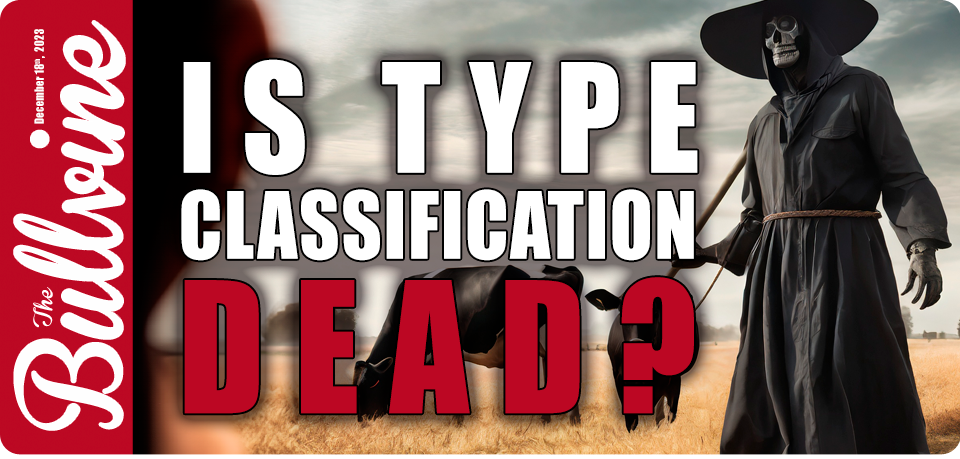To some, that statement may sound like blasphemy and think that I am insane. However, there is no question that the percentage of dairy cattle type classified in North America is on a steady decline. Farmers tell me that they can no longer obtain a ROI from type classifying their cows, while others say they only use it now for the information to be used in sire proving and mating programs offered by some artificial insemination companies. Combining these with the fact that there are now bulls being offered from the major artificial insemination companies that have three or more generations of unclassified direct mothers in their maternal line and you start to wonder, and eventually ask, “Is type classification still relevant to the modern dairy farm?”
Type Classification is Falling Short
Type classification has long been regarded as the gold standard for evaluating and categorizing the physical attributes of dairy cows. While this traditional human observation approach has had its merits, it also has its limitations. Going forward we may need to consider a more holistic approach when assessing, breeding and managing dairy herds.
There are several reasons why type classification may fall short of capturing the complete picture of a dairy cow’s potential and well-being. They include:
- Focus on Conformation Over Functionality:
Type classification prioritizes the aesthetic aspects of a dairy cow’s conformation, such as body shape and size. While those traits have been assigned importance in the past, they often do not align with a cow’s functional capabilities, including milk production and overall health.
By concentrating solely on physical appearance, type classification can overlook essential functional traits crucial for a cow’s ability to thrive in modern operations. Traits like locomotion, fertility, daughter calving ease and resistance to diseases are integral components of a cow’s overall contribution to a herd’s bottom line. Indexed traits such as Herd Life/Productive Life, Livability and Daughter Pregnancy Rate all have a significant connection to how long a cow will last in a herd and ultimately a direct alignment with lifetime production and cost minimization. - Genetic Advancements:
Rapid advancements in genetic technology and selective breeding have introduced cows with superior traits that may not align with traditional breed supported conformation standards. Relying primarily on type classification results may hinder the integration of these genetically advanced animals into a herd. Robotic milking systems and on-farm data management softwares integrated with DHI, A.I. and other service organization programs offer far greater opportunities, than type classification, to align with herd profitability goals. - Milk Production Variability:
Type classification provides limited insights into a cow’s actual milk-producing capabilities. Two cows with similar conformation can have significant differences in lactation and lifetime milk production. Therefore, primarily using type classification results can hinder a farmer’s ability to maximize their herd’s profitability. - Emerging Technologies for Comprehensive Assessment:
Modern dairy farming is increasingly embracing technologies such as sensor-based monitoring, genomic testing and artificial intelligence. These tools provide a more comprehensive understanding of a cow’s performance, health and genetic potential and surpass the insights offered by traditional type classification. - Data-Driven Decision Making:
Leveraging data-driven approaches enables farmers to make more informed decisions. This results in considering a broader spectrum of services beyond just physical conformation. This holistic approach ensures that the genetics, nutrition, reproduction and management of dairy cows aligns with the overarching goals of individual farms. - Investing in the Future
If you look at where the research money for genetic advancement is being spent, it is heavily weighted towards on-farm data collection combined with traits that are directly linked to profitability versus type classification traits that are an antiquated predictor of what profitability could be.
The Bullvine Bottom Line
While type classification has been a valuable tool in the history of dairy cattle improvement, its limitations in capturing the full scope of a cow’s potential are increasingly apparent. Embracing a more holistic approach that integrates modern technologies, production traits, feed and labor efficiency traits, functional traits and other new novel economically important traits is the way forward. A way whereby dairy farmers will be able to make decisions that optimize profit and sustainability.
Having grown up with a father who spent his early-career developing the Canadian Type Classification System, declaring that type classification is dying is not easy. But as I have learned from my father, you either lead, follow or get out of the way (Thomas Paine). If the type classification programs are no longer leading and are not following the path to the profitable modern dairy farm, then, type classification needs to get out of the way.
Get original “Bullvine” content sent straight to your email inbox for free.

















